Physical Address
304 North Cardinal St.
Dorchester Center, MA 02124
Physical Address
304 North Cardinal St.
Dorchester Center, MA 02124

Heading out for a camping adventure? Worried about those pesky ticks? Say goodbye to tick troubles with our ultimate guide on “How to Avoid Ticks While Camping.” We’ve got you covered with all the tips and tricks you need to keep those blood-sucking critters at bay.
No one wants unexpected guests hitching a ride on their outdoor excursion, right? Well, fret not! In this guide, we’ll spill the beans on foolproof strategies that will have you enjoying the great outdoors tick-free.
So, if you’re ready to say goodbye to tick bites and hello to worry-free camping, buckle up and dive into our essential tips and tricks. It’s time to reclaim your outdoor adventures without the annoying itch and worry!
Main Summary: How to Avoid Ticks While Camping?
To avoid ticks while camping, wear long sleeves and pants, use tick repellent, stay on marked trails, and check for ticks regularly. Keep your camping area tidy to reduce tick habitats and shower after outdoor activities to remove unattached ticks.
Ticks are tiny arachnids that can be a nuisance and potential health risk while camping. Their bites can transmit diseases like Lyme disease, so it’s crucial to take precautions. By implementing simple measures, you can significantly reduce your exposure to ticks.
This guide will provide you with practical tips and strategies to help you avoid ticks while enjoying your camping adventure. From proper clothing choices to effective repellents, we’ll cover everything you need to know to stay tick-free and make the most of your outdoor experience.

Camping in the great outdoors is a thrilling adventure that brings us closer to nature. However, it’s important to be aware of the potential risks, such as tick bites, and take necessary precautions to ensure a safe and enjoyable camping experience.
Ticks are small arachnids that can transmit diseases, including Lyme disease and Rocky Mountain spotted fever. These tiny creatures lurk in wooded areas, tall grasses, and shrubs, waiting for a warm-blooded host to pass by. To minimize the risk of tick bites, here are some key steps to follow:
Before heading out into the wilderness, it’s crucial to familiarize yourself with ticks. These pests have eight legs and vary in size depending on their life stage. Nymphs, the most common tick stage encountered by campers, are about the size of a poppy seed, making them difficult to spot. Adult ticks are larger and more visible, resembling small spiders.
Ticks latch onto their hosts by climbing onto clothing or skin and then burrow into the skin to feed on blood. They prefer warm and moist areas, such as the armpits, groin, and scalp. Ticks can transmit diseases within 24 to 48 hours of attachment, highlighting the importance of early detection and prevention.
Proper attire plays a crucial role in protecting yourself from ticks while camping. Opt for light-colored clothing, as it makes it easier to spot crawling ticks. Long sleeves and pants are essential to minimize skin exposure. Tuck your pants into your socks or boots and secure your shirt into your pants to create a barrier that prevents ticks from reaching your skin.
Consider treating your clothing with a permethrin-based repellent, which effectively repels and kills ticks. Permethrin is a synthetic insecticide that can be applied to clothing, shoes, and camping gear. It provides long-lasting protection even after multiple washes, making it an excellent choice for extended camping trips.
Performing regular tick checks is an essential practice for campers to minimize the risk of tick-borne diseases. Conduct a thorough inspection of your body and clothing after spending time outdoors, paying extra attention to hard-to-see areas. Use a mirror or ask a camping buddy to assist with checking hard-to-reach spots like the back, neck, and scalp.
If you find a tick attached to your skin, remove it promptly using fine-tipped tweezers. Grasp the tick as close to the skin’s surface as possible and pull upward with steady pressure. Avoid twisting or jerking the tick, as this may cause the mouthparts to break off and remain embedded in the skin. After removal, clean the area with soap and water, and apply an antiseptic to prevent infection.
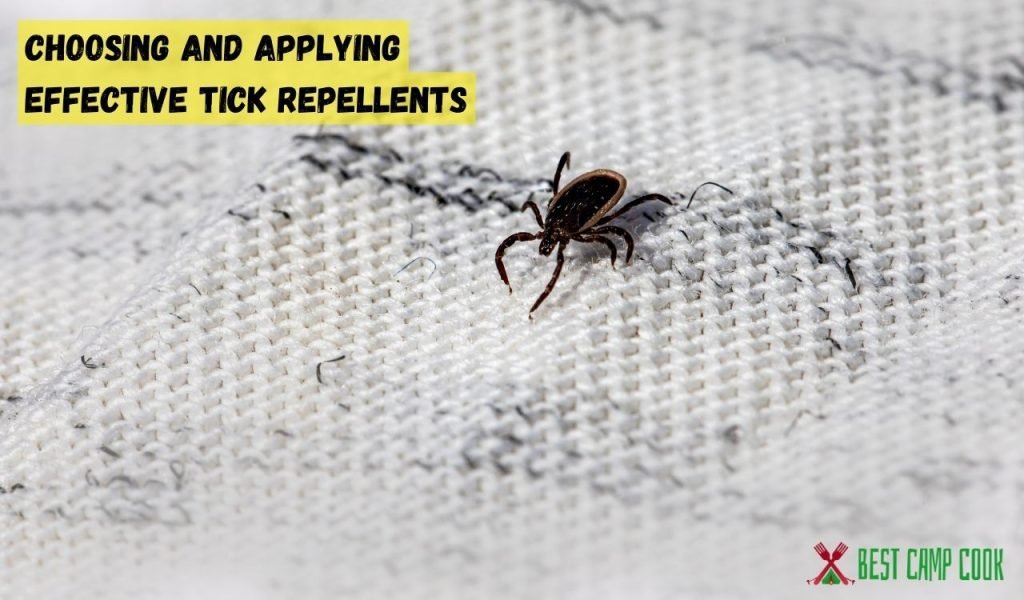
Preventing tick bites is crucial to ensure a worry-free camping experience. Choosing and applying effective tick repellents will provide an added layer of protection against these tiny pests. Here are some key considerations when selecting and using tick repellents:
DEET (N,N-diethyl-meta-toluamide) is a widely used and highly effective tick repellent. It is available in various concentrations, typically ranging from 10% to 30%. Higher concentrations offer longer-lasting protection but may also increase the risk of skin irritation. Apply DEET-based repellents to exposed skin, avoiding contact with eyes, mouth, and open wounds.
Picaridin is another effective tick repellent that provides long-lasting protection without the strong odor associated with DEET. It is gentle on the skin and is available in different concentrations. Apply picaridin-based repellents following the manufacturer’s instructions, and reapply as needed, especially after swimming or excessive sweating.
While natural repellents may seem appealing, their effectiveness against ticks is often limited. Substances such as essential oils, including lemon eucalyptus oil, may provide some degree of protection, but they generally offer shorter-lasting effects compared to DEET or picaridin. If you opt for natural repellents, reapply them frequently to maintain effectiveness.
To maximize the effectiveness of tick repellents, proper application is key. Ensure thorough coverage of exposed skin, paying attention to commonly overlooked areas like the back of the knees, ankles, and hairline. When applying to the face, spray the repellent onto your hands first and then carefully apply it, avoiding contact with the eyes and mouth.
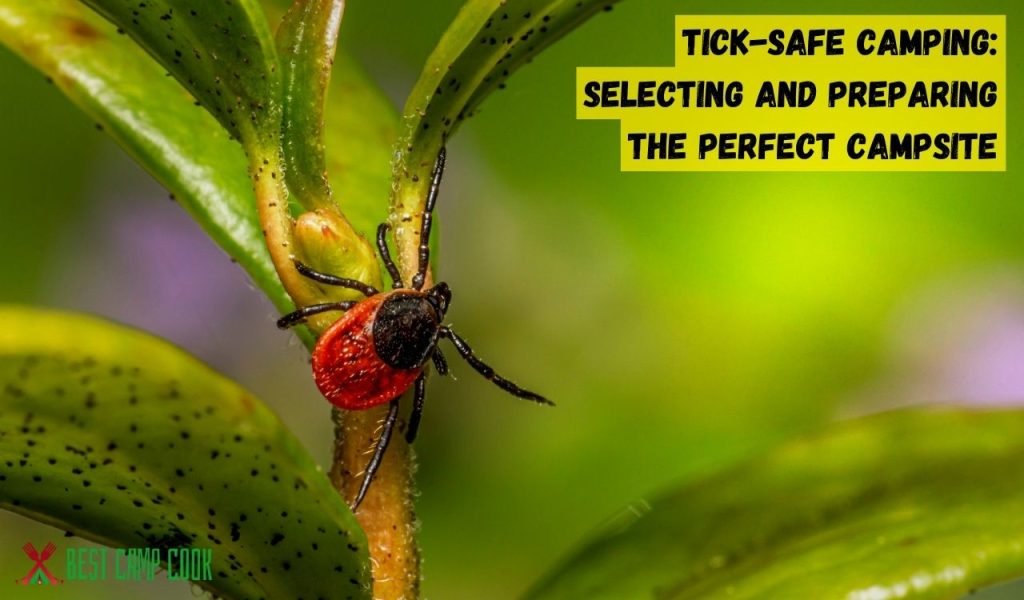
Choosing a tick-safe campsite is essential to minimize exposure and reduce the risk of tick bites. Follow these tips to select and prepare a campsite that will help keep ticks at bay:
Ticks thrive in wooded areas with tall grasses and dense shrubs. When selecting a campsite, choose open and sunny areas, as ticks prefer shady and humid environments. Avoid camping near animal trails, as wildlife can transport ticks to your campsite. Additionally, steer clear of areas with decaying leaf litter, as ticks tend to congregate in such locations.
Before setting up your campsite, create a physical barrier to deter ticks from reaching your camping area. Clear the immediate vicinity of your campsite from tall grasses and brush. Consider using wood chips or gravel as a buffer zone to further discourage ticks from venturing closer. Regularly inspect this perimeter to ensure no ticks have breached the barrier.
Ticks thrive in cluttered environments, so keeping your campsite clean and organized is crucial. Store camping gear in sealed containers or hang it off the ground to minimize tick exposure. Shake out clothing and inspect camping equipment before bringing them inside your tent. Regularly sweep the tent floor and sleeping areas to remove any hitchhiking ticks.
Create a tick-free zone within your tent by applying permethrin-based sprays or powders to the exterior surfaces. This additional layer of protection can deter ticks from crawling onto your tent and gaining access to your sleeping area. Consider using a bed net or sleeping on a raised cot to further reduce the risk of tick bites while you sleep.
Ticks can pose a risk of transmitting diseases, such as Lyme disease, while you’re enjoying the great outdoors. To minimize the chances of tick bites and stay protected during your camping trips, it’s important to have the right gear and clothing. Here are some essential items to consider:
Choose a repellent that is specifically formulated to repel ticks, containing active ingredients like DEET or picaridin. Apply the repellent to exposed skin, paying close attention to areas where ticks are commonly found, such as ankles, legs, and arms. Reapply the repellent as instructed on the product label, especially after swimming or excessive sweating.
Opt for lightweight, long-sleeved shirts and pants made of tightly woven fabric to create a physical barrier between your skin and ticks. Tuck your pants into your socks or boots and ensure your shirt sleeves are long enough to cover your wrists. Light-colored clothing can make it easier to spot ticks.
Consider treated clothing with built-in tick repellent, such as permethrin-treated apparel. Permethrin is an insecticide that can repel and kill ticks upon contact. Follow the instructions provided by the manufacturer for proper usage and reapplication of tick-repellent clothing.
Wearing a hat with a wide brim can protect your head, neck, and face from tick bites. Use a bandana or headband treated with tick repellent to create an additional barrier and keep ticks away from your hairline.
Wear high-quality, long socks that can be pulled up over your pants. This helps prevent ticks from crawling up your legs. Choose closed-toe shoes or boots that provide adequate coverage and are difficult for ticks to penetrate.
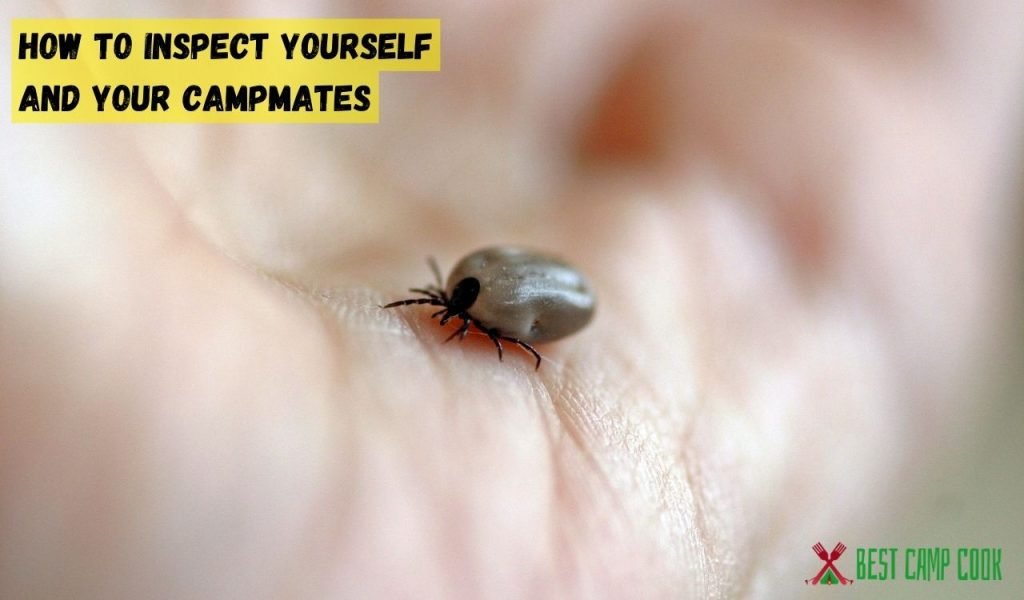
Performing thorough tick inspections on yourself and your fellow campers is crucial to detect and remove any ticks before they have a chance to transmit diseases. Follow these steps to conduct a proper tick check:
Check your body for ticks at least once a day, paying close attention to areas where ticks tend to hide, such as behind the ears, along the hairline, in armpits, groin area, and between toes. Ensure that every member of your camping group, including children and pets, undergoes regular tick inspections.
Utilize a handheld mirror to examine hard-to-see areas, such as your back or the back of your legs. Make sure you have sufficient lighting, either natural or using a flashlight, to spot tiny ticks or nymphs.
Start from the top of your head and work your way down, systematically checking your scalp, face, neck, torso, arms, legs, and feet. Pay attention to any unusual bumps or skin discoloration, as ticks can sometimes be easily mistaken for moles or freckles.
Slowly scan your body using your fingers, feeling for any small bumps or irregularities. Be thorough and take your time, as ticks can be as small as a poppy seed and may require careful scrutiny to detect.
If you find a tick attached to your skin, use fine-tipped tweezers to grasp the tick as close to the skin’s surface as possible. Gently pull upward with steady pressure, without twisting or jerking, to ensure you remove the entire tick. Clean the bite area with soap and water or an antiseptic after tick removal.
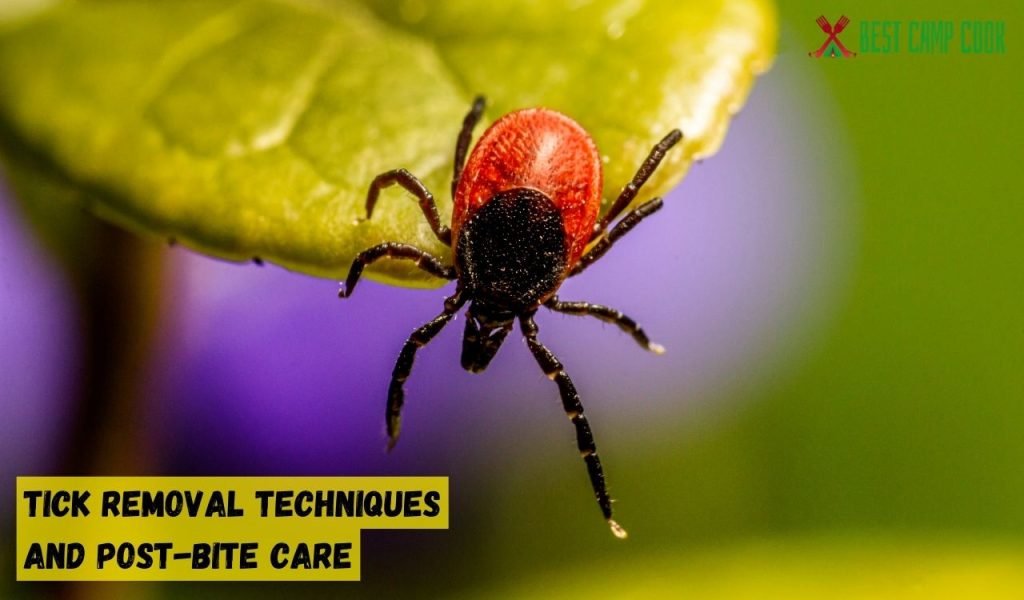
In the event that you or your campmates are bitten by ticks, knowing the proper tick removal techniques and post-bite care is essential. Follow these guidelines to minimize the risk of infection:
Use fine-tipped tweezers to grasp the tick as close to the skin as possible.
Pull upward with a steady motion, being careful not to crush the tick’s body. Dispose of the tick by placing it in a sealed bag or container, or flushing it down the toilet. Clean the bite area with soap and water, and apply an antiseptic.
Monitor the bite site for any signs of infection, such as redness, swelling, or pus. If you notice any concerning symptoms or develop a rash, seek medical attention promptly.
Consider saving the tick in a sealed container if you develop any symptoms after the bite. This can assist healthcare professionals in identifying potential tick-borne illnesses.
Keep a record of the date and location of the tick bite. Stay vigilant for any symptoms of tick-borne diseases, such as fever, fatigue, muscle aches, or a bulls-eye rash. If you experience any unusual symptoms, consult a healthcare professional and provide them with information about the tick bite.
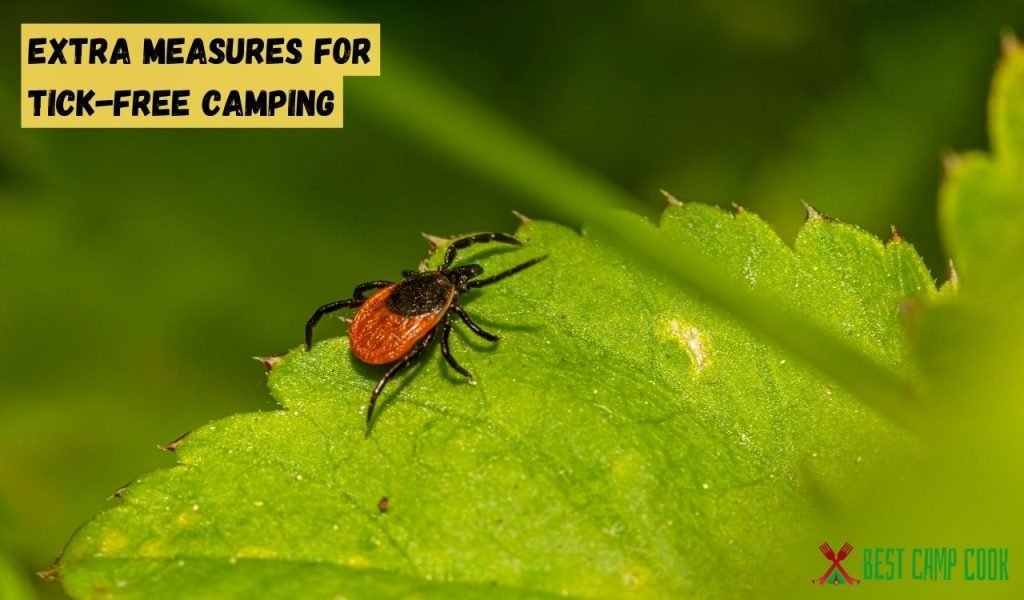
In addition to essential gear and clothing, there are extra measures you can take to further ensure a tick-free camping experience. Consider the following precautions:
Choose a camping spot away from tall grass, dense vegetation, and areas frequented by wildlife, as these are prime tick habitats. Clear the immediate camping area of leaf litter, brush, and debris that may attract ticks.
Set up a physical barrier around your camping area to deter ticks from approaching. This can be achieved by creating a perimeter using wood chips, gravel, or a band of diatomaceous earth, a natural substance that can help repel ticks.
Inspect your camping gear, including tents, sleeping bags, and backpacks, for any signs of ticks or their eggs. Shake out and thoroughly inspect clothing, camping equipment, and gear before packing them up to leave the campsite.
Consider using perimeter repellents, such as tick tubes or sprays, around your camping area to create a barrier that repels ticks. Follow the instructions provided by the manufacturer for proper application and reapplication of these repellents.
Use tick-preventive products on your pets, such as tick collars, spot-on treatments, or oral medications recommended by your veterinarian. Regularly check your pets for ticks and promptly remove any you find.

To minimize the risk of tick bites, it’s important to avoid tick-prone areas and activities that may increase your exposure. Follow these guidelines:
Stick to well-maintained trails and avoid venturing into overgrown or heavily wooded areas where ticks are more prevalent. Stay in the center of the trail to reduce contact with vegetation where ticks may be waiting.
Avoid walking through tall grass, brush, or leaf litter, as these are common hiding spots for ticks. If you need to pass through tick-prone areas, tuck your pants into your socks and use a stick to brush off any ticks that may attach to your clothing.
Ticks are most active during warm months, typically from spring to fall. Be particularly cautious during early mornings, late afternoons, and evenings when ticks are more likely to be active.
When selecting a camping site, opt for areas that are sunny, dry, and have a breezy environment. Ticks prefer humid and shaded environments. Avoid camping near areas with stagnant water sources, as they attract wildlife and increase the likelihood of encountering ticks.
Ticks often hitch a ride on animals, so it’s important to minimize contact with wildlife while camping. Avoid feeding or attracting animals to your camping area, and store food securely to discourage wildlife from approaching.
Staying informed about tick-related updates and resources can help you stay prepared and aware of potential risks. Here are some valuable sources of information:
Check the websites or contact the local health departments of the camping area you plan to visit for information on tick activity, tick-borne diseases, and prevention tips specific to the region.
Reach out to national or state park offices for guidance on tick safety measures, any recent alerts or advisories, and recommended precautions for camping in their parks.
Some regions have tick surveillance programs that collect data on tick populations and associated diseases. Stay informed about the findings and recommendations from these programs to understand the local tick situation.
The CDC provides comprehensive information on tick-borne diseases, prevention strategies, and updates on emerging tick-related issues. Visit the CDC website for valuable resources and guidelines.
Outdoor and camping organizations often provide educational materials, articles, and resources on tick prevention. Check their websites or publications for information tailored to outdoor enthusiasts.
In conclusion, taking proactive measures to avoid ticks while camping is essential for your safety and well-being. Choose your campsite wisely, away from tall grass and wooded areas.
Wear appropriate clothing, including long sleeves, pants tucked into socks, and light-colored attire. Use insect repellents containing DEET or picaridin, and consider treating your clothing with permethrin.
Perform regular tick checks on yourself and your camping gear. By following these precautions, you can minimize the risk of tick encounters and enjoy a safe camping experience.
To protect your tent from ticks, there are a few measures you can take. Firstly, choose a camping spot away from tall grass and wooded areas, where ticks are commonly found.
Use a groundsheet under your tent to create a physical barrier. Additionally, consider treating your tent with a permethrin-based insecticide, which can repel and kill ticks on contact.
Ticks are repelled by certain smells, and one scent they dislike is that of essential oils like lavender, eucalyptus, and peppermint. These oils can be mixed with a carrier oil, such as coconut or almond oil, and applied to your skin or clothing as a natural tick repellent.
However, it’s important to note that while these scents may help deter ticks, they should not be relied upon as the sole method of tick prevention.
To prevent ticks from climbing on you, follow these precautions. Wear long-sleeved shirts and long pants tucked into your socks or boots. Use insect repellents containing DEET or picaridin on exposed skin.
Perform regular tick checks on yourself and remove any ticks promptly. Consider treating your clothing with permethrin, an insecticide that repels ticks. These measures combined can help reduce the risk of ticks climbing on you.
Yes, there are natural methods to prevent ticks. Some options include using essential oils like cedar, rosemary, or lemongrass as natural tick repellents.
Additionally, maintaining a well-maintained yard, removing leaf litter, and keeping grass and shrubs trimmed can help reduce tick populations around your home.
Remember, natural methods may be effective to some extent but may not provide complete protection, especially in high-risk areas.
Ticks are not specifically attracted to any particular color. They primarily rely on detecting movement, heat, and the presence of carbon dioxide to locate potential hosts.
The notion that ticks are attracted to specific colors is a misconception. However, it’s still important to wear light-colored clothing when in tick-prone areas, as it makes it easier to spot ticks crawling on your clothing.
Ticks do not hate chlorine. Chlorine is commonly used as a disinfectant in swimming pools, but it does not have a significant effect on ticks.
While chlorine can kill or deter some aquatic organisms, ticks are primarily terrestrial creatures and are not directly affected by chlorine in the same way as water-dwelling organisms.
Ticks are not completely waterproof but possess certain adaptations that allow them to survive in moist environments. They have a tough outer exoskeleton that helps retain moisture and prevent dehydration.
Ticks can withstand exposure to water and moisture for extended periods and even swim when necessary. However, excessive moisture or submersion in water for prolonged periods can still negatively affect their survival.
While vinegar has some household uses, there is limited scientific evidence to support its effectiveness in repelling ticks. While some people claim that vinegar can deter ticks, its efficacy is not well-established.
It’s generally recommended to rely on proven tick repellents, such as those containing DEET or picaridin, for better protection against ticks.
When it comes to clothing choices to minimize tick exposure, there are a few recommendations. Opt for light-colored clothing as it makes it easier to spot ticks crawling on your clothes.
Wear long-sleeved shirts, long pants, and tuck your pants into your socks or boots to create a physical barrier. Additionally, choose clothing made of tightly woven fabrics that are more difficult for ticks to penetrate.
Consider treating your clothing with permethrin, an insecticide that repels ticks, for added protection.